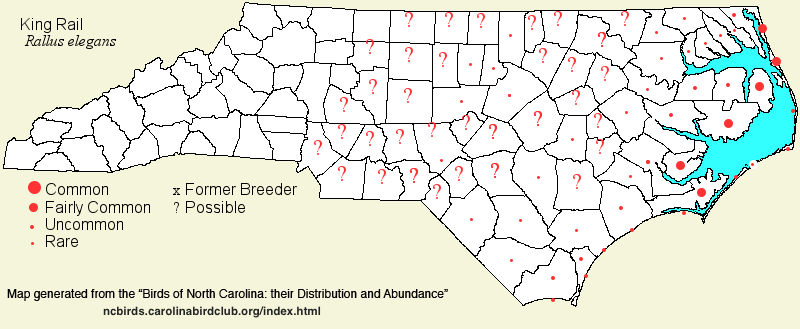 |  |
|
King Rail - Rallus elegans RALLIDAE Members: | Search Common: Search Scientific: |
|
|
|||||||
| General Comments | Slightly larger than the Clapper Rail, and the freshwater/inland counterpart of that species, the King Rail is considered by some to be conspecific with the Clapper Rail. Some races of the Clapper Rail in the Western states are somewhat rusty, and where the two "species" overlap in brackish marshes, songs of the two seem to converge (i.e., be somewhat similar to each other than where separate in fresh marshes and salt marshes) instead of being more divergent. However, as the American Ornithological Society has recently split off new species from various King and Clapper populations in the western half of the continent, there is little to no chance of King and Clapper being lumped any time soon -- a good thing for listers. At any rate, King Rails are much less often found than Clapper Rails, seldom occurring in large numbers, and many details of its breeding and winter range in North Carolina and the East are still not well known. The species breeds in the state mainly in extensive freshwater marshes and wet grasslands, both near the coast and sporadically inland; also, Kings nest in brackish marshes, favoring those with more diverse flora than those dominated by black needlerush (where Clappers tend to occur). | ||||||
| Breeding Status | Breeder | ||||||
| NC BRC List | Definitive | ||||||
| State Status | W | ||||||
| U.S. Status | |||||||
| State Rank | S3B,S3N | ||||||
| Global Rank | G4 | ||||||
| Coastal Plain | Permanent resident near the coast, with migratory movements; status farther inland poorly understood. Mostly uncommon to locally fairly common breeder in extensive freshwater marshes, such as at Great Marsh in Mackay Island NWR (Currituck) and at Pamlico Point marshes (Pamlico) in the Tidewater zone and along the coast. Status in winter is similar to the breeding season, but as calling is reduced in winter, range and abundance is not well known. Farther inland, there are few records, but perhaps has nested near Fayetteville at a sand and gravel company marsh and likely nests at a few other places, such as Lake Surf (Moore) and the Voice of America site (Beaufort). A few winter records from inland, such as 5, Halifax, 14 Jan 1993. Singles were reported far inland in winter 2023-24, with birds heard at Lake Surf (Moore) on 16-17 Dec and seen near Clarkton (Bladen) on 18 Jan. Peak counts: 32, Mackay Island NWR, 14 Jun 2022; 30, Knotts Island (Mackay Island NWR), 16 Jan 1988; 25 at that refuge, 26 Apr 2013. | ||||||
| Piedmont | Poorly known, but transient and local summer resident (at least formerly, when there were scattered breeding records over portions of the province). Has nested, or presumed to have nested, near Raleigh, at Jordan Lake (when filling), Falls Lake (when filling); in Durham, Mecklenburg, and in Cleveland. In recent decades, rare in migration and in the nesting season in the Triangle area, but casual to very rare migrant over the rest of the Piedmont. One photographed at Mountain Creek Park (Catawba) from 8-14 May 2025 was notable for the western Piedmont. Mostly late Apr to mid-Sep. Three winter reports, all in Wake: 1, Lake Raleigh, 16 Feb 1966; 1, Lake Benson, 11 Feb 1977; and 1 (heard) on several dates from 10 Jan into Mar 2020. Peak counts (not including chicks): 6 heard, White Oak Creek arm of Jordan Lake, 2 May 2010; 4, Greenview Farm (Wake), May 1979. | ||||||
| Mountains | Accidental stray/migrant. Two records: one, downtown Asheville (grounded migrant), 25 Apr 2002; and 1, Hooper Lane (Henderson), 31 Oct 2004. | ||||||
| Finding Tips |
This species is somewhat local, and because freshwater marshes are spottily located in some areas of the coast, you might need to do some searching to find suitable habitat. It is widespread in the Currituck marshes. Look and listen for them along the Mackay Island causeway and at the Waterlily marshes. They can also be found at Alligator River NWR along Milltail Road near the maintenance area, at marshes at the Mattamuskeet NWR, and at the USS North Carolina battleship marshes. ** | ||||||
| Attribution | LeGrand[2025-07-23], LeGrand[2024-10-29], LeGrand[2024-08-02] | ||||||
| NC Map Map depicts all counties with a report (transient or resident) for the species. | Click on county for list of all known species. |
| NC Breeding Season Map Map depicts assumed breeding season abundance for the species. |  |